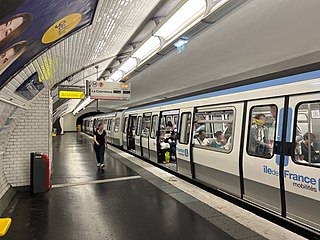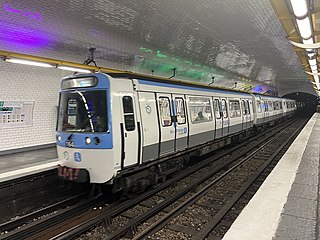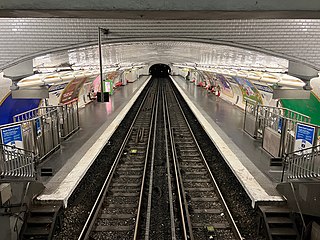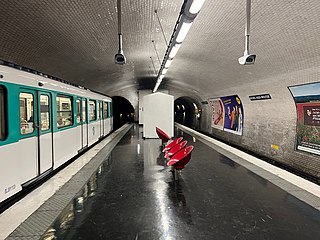
Poissonnière is a station on Line 7 of the Paris Métro. It is located near the junction between rue La Fayette and rue du Faubourg Poissonnière, after which it is named and along which fishmongers brought fish from Boulogne-sur-Mer and other harbours on the Channel coast to the market at Les Halles in chasse-marées. The route from the coast generally followed that of a Roman Road and entered nineteenth century Paris at the Porte des Poissonniers.

Jaurès is a station on Paris Métro line 2, line 5, and line 7bis in the 10th and 19th arrondissements.

Ménilmontant is a station on Line 2 of the Paris Métro, on the border of the 11th and 20th arrondissements.

Vavin is a station of the Paris Métro on line 4 on the border of the 6th arrondissement and 14th arrondissement, under Place Pablo-Picasso at the intersection of Boulevard du Montparnasse and Boulevard Raspail. It is named after the nearby rue Vavin, named after 19th-century statesman Alexis Vavin (1792-1863).

Bobigny–Pantin–Raymond Queneau is a station on line 5 of the Paris Métro, located on the border between the communes of Pantin and Bobigny, in Seine-Saint-Denis, Île-de-France. It is named after the communes of Bobigny and Pantin, as well as the nearby rue Raymond Queneau, named after Raymond Queneau (1903-1976), a 20th-century French author and member of the Oulipo group whose most famous works were Zazie dans le métro and Exercices de style, set on a bus. Despite its name, the station serves mainly Pantin and Romainville. It only serves a thin industrial fringe in Bobigny.

Hoche is a station of the Paris Métro, serving line 5. It is named after the nearby rue Hoche, which in turn was named after Lazare Hoche (1768-1797), a general during the French Revolution who at the age of 25, commanded the Army of the Moselle in which he drove the Austrians back to Wœrth, cleared Landau and Alsace. The platform in the direction of Bobigny contains in a display case where a bust of Lazare Hoche as well as several images evoking his life as a general were installed.

Porte de Pantin is a station of the Paris Métro, serving line 5. It is named after the nearby avenue de la Porte de Pantin, on the edge of Paris leading to the town of Pantin. It was in turn named after the nearby Porte de Pantin, one of the former gates of Paris. The station's name has been subtitled Parc de la Villette since the creation of the eponymous park in 1987 on the site of the former slaughterhouses of La Villette to the north of the station which closed in 1974.

Laumière is a station of the Paris Métro on line 5 in the 19th arrondissement. It is named after the nearby avenue de Laumière, which was in turn named after Xavier Jean-Marie Clément Vernhet de Laumière (1812-1863), a general killed during the French intervention in Mexico in the 19th century.

Corentin Cariou is a station of the Paris Métro.

Crimée is a station of the Paris Métro and is located in the 19th arrondissement of Paris under avenue de Flandre. The station is named after the nearby rue de Crimée, the longest road in the arrondissement, whose name commemorates the Crimean War (1855–56), on the Crimean Peninsula of the Russian Empire on the Black Sea, where a coalition of Turkey, the United Kingdom, France, and Piedmont faced Russia. It was notable for the Siege of Sevastopol (1854–1855) and the Charge of the Light Brigade. The conflict ended in the Treaty of Paris (1856), with the Russian Empire's defeat.

Riquet is a station of the Paris Métro and located in the 19th arrondissement of Paris.

Les Gobelins is a station on line 7 of the Paris Métro on the edges of the 5th and 13th arrondissements.

Montgallet is a station on line 8 of the Paris Métro in the 12th arrondissement. It is named after the nearby rue Montgallet, which is in turn named after the former owner of the land on which the road was built upon. Rue Montgallet is well known in Paris for its computer shops.

Michel Bizot is a station on line 8 of the Paris Métro in the 12th arrondissement. It is named after the nearby avenue du Général-Michel-Bizot, which is in turn named after the French military engineer General Michel Brice Bizot (1795–1855), fatally shot at the siege of Sevastopol during the Crimean War.

Liberté is a station on line 8 of the Paris Métro in the commune of Charenton-le-Pont. It is named after the nearby avenue de la Liberté which runs above the station, it refers to the motto of the France: Liberté, égalité, fraternité.

Exelmans is a station on line 9 of the Paris Métro. It owes its name to its proximity to boulevard Exelmans, which was in turn named after Rémi Joseph Isidore Exelmans (1775-1852), a general of Napoleon's cavalry.

Ranelagh is a station on line 9 of the Paris Métro located in the 16th arrondissement.

Maraîchers is a station on line 9 of the Paris Métro in the 20th arrondissement of Paris, located under the rue d'Avron. It is named after the nearby rue des Maraîchers. It in turn took its name from the market gardens "maraîchers" once located there; until the 20th century, the hills of Belleville and Montreuil were cultivated by many market-gardeners whose most famous product were the peaches from Montreuil.

Michel-Ange–Molitor is a station of the Paris Métro in the 16th arrondissement, serving as an interchange between Line 9 and Line 10. It is named after the nearby rue Michel-Ange, which was in turn named after Michelangelo as well as the nearby rue Molitor, which was named after Count Gabriel-Jean-Joseph Molitor (1770–1849), a Marshal of France.

La Tour-Maubourg is a station on line 8 of the Paris Métro. It is located to the northwest of Hôtel des Invalides in the 7th arrondissement. It is named after the Boulevard de la Tour-Maubourg, which in turn is named after Victor de Fay de La Tour-Maubourg (1768–1850), a general in the First Empire and Minister of War after the Restoration. He also served as the governor of the nearby Hôtel des Invalides from 1821 to 1830.


























